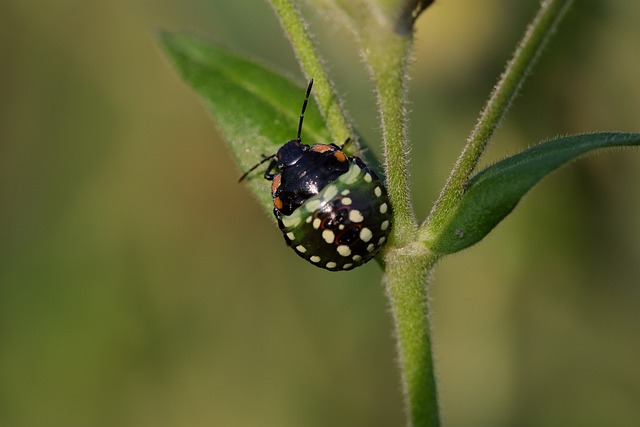The sowbug life cycle involves distinct stages from egg to adult, with key requirements for survival and adaptation. Understanding this cycle is crucial for implementing effective pest control through customized sowbug control plans. These plans target specific developmental phases, focusing on environment management, exclusion methods, and insect growth regulators. Regular inspections, monitoring, and dynamic adjustments ensure long-term success in maintaining a sowbug-free environment.
“Unraveling the sowbug life cycle is a key strategy in effective pest control. These tiny creatures, often overlooked, can cause significant damage to fabrics and textiles. Our guide offers a comprehensive understanding of sowbugs’ distinct stages, from eggs to adults, providing insights into their behavior and preferred habitats.
We delve into ‘customized sowbug control plans’, emphasizing a strategic approach tailored to specific environments. By combining targeted methods with continuous monitoring, we ensure successful sowbug management, offering peace of mind in a world where these pests can thrive.”
Sowbug Life Cycle: Understanding the Different Stages
The sowbug, or armadillo bug, life cycle is a fascinating yet complex process that plays a significant role in their ability to thrive and adapt. These tiny insects undergo several distinct stages during their development, each crucial for their survival. The lifecycle begins with eggs, which are typically laid in warm, moist environments. After hatching, the young sowbugs, or nymphs, emerge, resembling miniature versions of the adults but lacking wings. This stage is characterized by rapid growth and molting as they shed their exoskeletons to accommodate their increasing size.
As they mature, sowbugs progress through several nymphal stages, molting and growing larger with each transition. This process can take several weeks, depending on environmental conditions. Upon reaching maturity, the final stage of the lifecycle is reached, producing either male or female adults capable of reproduction. Understanding these different life cycle stages is integral to implementing effective pest control strategies. Customized sowbug control plans can be tailored to target specific stages, ensuring a more comprehensive and successful approach to managing their population.
Identifying Sowbugs and Their Habitats
Sowbugs, also known as armadillos without a shell, are small, wingless insects that belong to the family Ctenidae. They are easily identifiable by their elongated antennae and a distinct, hard exoskeleton that resembles armor. These creatures can range from 3 to 4 mm in length, making them nearly imperceptible against rough surfaces like bark or stone. Sowbugs are nocturnal and prefer dark, moist habitats, often found in areas with high organic matter content such as compost piles, mulched gardens, or damp cellars. Their ability to survive in diverse environments makes them a persistent pest, necessitating tailored sowbug control plans for effective management.
Identifying sowbug infestations early is crucial for implementing customized control strategies. Homeowners and commercial property managers should look out for signs like damage to seedlings, small holes in fabric or cardboard, or the presence of a distinctive scent similar to mushrooms. Understanding their preferred habitats allows for targeted treatments, utilizing appropriate methods and products to disrupt their life cycle without affecting non-target organisms. This proactive approach ensures not only effective sowbug control but also minimizes environmental impact, contributing to a healthier ecosystem.
Customized Sowbug Control Plans: A Strategic Approach
Understanding the sowbug life cycle is key to developing effective pest control strategies. One powerful tool in a professional’s arsenal is the implementation of customized sowbug control plans. These tailored plans recognize that every environment presents unique challenges and requires specific solutions. By assessing factors like habitat, food sources, and seasonal variations, pest management specialists can craft targeted interventions.
A strategic approach involves identifying breeding grounds and taking proactive measures to disrupt the sowbug lifecycle. This might include implementing exclusion methods, such as sealing entry points, and utilizing insect growth regulators (IGRs) to impede their development. Regular inspections and monitoring are crucial components, allowing for swift identification of any sowbug activity and ensuring the control plan remains effective over time.
Effective Implementation and Continuous Monitoring for Success
For effective implementation of sowbug control, it’s crucial to create and adhere to customized sowbug control plans tailored to specific environments. These plans should encompass integrated pest management strategies, combining chemical and non-chemical methods for a comprehensive approach. Regular inspections and prompt treatment are vital; identifying sowbugs early and targeting their hiding places can prevent infestations from escalating. Continuous monitoring involves staying vigilant throughout the year, as sowbugs may be more active during certain seasons or in specific climate conditions.
Successful pest control requires adaptability and ongoing assessment. As sowbug behaviors and populations fluctuate, so should control measures. Regular reviews of control plans enable adjustments to stay ahead of evolving patterns, ensuring a dynamic and effective strategy. Continuous monitoring also facilitates early detection of resistance to chemical treatments, allowing for timely changes in tactics to maintain the long-term success of sowbug control efforts.
Understanding the sowbug life cycle is key to implementing effective pest control strategies. By grasping the different stages, identifying these insects in their natural habitats, and adopting customized sowbug control plans, property owners and managers can successfully mitigate infestations. A strategic, multi-pronged approach that combines accurate identification, tailored treatments, and continuous monitoring ensures long-term success in managing sowbugs and maintaining pest-free environments.
